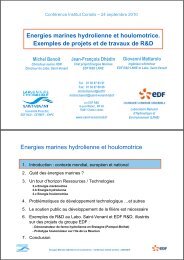Predictable? - Institut Coriolis - Ecole Polytechnique
Predictable? - Institut Coriolis - Ecole Polytechnique
Predictable? - Institut Coriolis - Ecole Polytechnique
Create successful ePaper yourself
Turn your PDF publications into a flip-book with our unique Google optimized e-Paper software.
Motivation-Increasing demand for climate projections on time scales of one or twodecades and on regional spatial scales (e.g. for water resources,agriculture, fisheries, insurance)-Concerns about the possibility of abrupt climate changesMotivating examples:1-US drought: summer 20122-Rapid decadal-scale loss of Arctic sea ice: July 2012 minimum
Drought-damaged corn in a field. Nebraska,Aug. 16, 2012. (AP Photo/Nati Harnik)Natural variability? Forced?<strong>Predictable</strong>? If yes, for the rightreasons?What confidence to give toretrospective forecasts when theyare right?2012 US droughtMost extensive U.S. drought since the 1930sDust Bowl.Over a six-state region--Wyoming, Kansas,Nebraska, Colorado, Missouri and Iowa--precipitation during 2012 was only 53% of thelong-term average=> driest year since record began in 1895.$35 billion damage. 123 people killedSecond hottest summer on record.Successfully predicted by the GFDLmodel but discarded because outlier
Could we have predicted the minimum of sea-ice?NASA image2012 had the lowest summer sea ice extent everrecorded since satellite measurementsstarted
Has this low sea-ice extent persisted?2013 summer sea-ice extent remainsbelow climatology but recovered tovalues close to that reached in 2006Large year-to-year variabilitysuperimposed on the trend
Results of the recent predictionsInternational prediction effort SEARCHMedian predicted value close to 2012.GFDL predictions stand out as thoseindicating the least 2013 Arctic sea-iceloss. Seems to verify with observationsGFDL predictionsMedian of SEARCH predictionshttp://nsidc.org/arcticseaicenews/observationsPost-season analysis needed tounderstand the reasons for success orfailure of the predictions
2012 had anomalous atmospheric conditions (unpredictable)http://nsidc.org/arcticseaicenews/
Key questions-What are the relative roles of radiative forcing and natural climate variability inthese variations/phenomena?-Are these variations (partly) predictable?A prediction is a probabilistic statement that something will happen in the future based onwhat is know todayA projection is a probabilistic statement that it is possible that something will happen in thefuture if certain conditions develop
The ocean, memory of the climate systemMajor climatic events are linked to multidecadal cycles in ocean temperature20-30 yrsPacific Decadal Oscillation (PDO):Averaged North Pacific SSTrelated to enhanced biological productivity,number of fires western US, ...60 yrsAtlantic Multidecadal Oscillation (AMO):Averaged North Atlantic SSTrelated to Sahel/India droughts, hurricaneactivity, European heat waves, fishdistribution(Rowell et al. 1995, Folland et al. 2001, Goldenberg et al. 2001, Sutton andHodson 2005, Nye et al. 2010)Question: Is it an oscillation (only 2 cycles)? Are observations long enough toassess the existence of this interdecadal/multidecadal variability?
Paleo-data support the existence of multi-decadal variabilityin the AtlanticSpectra of paleoclimatic records from Puerto Rico corals (left) andCariaco Basin (right). Both show distinct multidecadal variability.Kilbourne et al. (2008)-Proctor et al. (2002): Scotland stalagmites NE Atl 50-70yr-D’Arrigo et al. (2003): Labrador tree rings NW Atl 40-60 yr-Gray et al. (2004): Tree rings reconstruction of AMO 60-100 yr-Kilbourne et al. (2008): Puerto Rico corals 60yr-Shanahan et al. (2009): African lake level reconstruction of AMO Kilbourne 30-50 et yr al, 2008
Why look to the Atlantic fordecadal predictability?The Atlantic is “THE” place...North Atlantic TemperatureWhat will the next decadeor two bring?Warm North Atlanticlinked to …DroughtWhat caused thisrapid warming?More intense hurricanesOther examples include:• Multidecadal Arctic variability• US drought• African droughtCourtesy Tom DelworthMore rainover Saheland westernIndiaDecadal variability:• Significant climate influences- regional to hemispheric• Can phase with longer term warming to causeabrupt change• Some predictability possible• Crucial need to attribute observed changesJ"
What drives this Atlantic decadal variability?to the overturning, Broecker’s provided a tem-Observed AMO index andporal context.associated SST anomaliesKnight et al. (2005)Changing OceansSince these efforts, oceanographers havecollectively supported the paradigm that the ocean“conveyor belt” transports recently ventilatedwaters from the subpolar North Atlantic alongthe “lower limb” of the conveyor belt to the restof the global ocean, where thewaters are upwelled and then transportedalong the “upper limb” backto deepwater formation sites. Thisconveyor belt is assumed to operatecontinuously along western boundarycurrents in the deep ocean, bevulnerable to changes in deepwaterproduction at high latitudes due tovariable buoyancy forcing, andprovide a continuous supply ofrelatively warm surface waters todeepwater formation sites. Since itsinception, oceanographers have understoodthat the conveyor modelgrossly oversimplifies the mechanicsand pathways of the overturning:No one expects a water parceltagged at the surface in the northernNorth Atlantic to be swept alongthe conveyor belt unimpeded in itsequatorward, surfaceward, and ultimatelypoleward progress. However,this conceptual model hasstill fostered expectations for theresponse of the ocean’s circulationto a warming climate: If high-latitudesurface waters warm or freshen,deepwater production would diminishor cease. Because the conveyorbelt is assumed to be drivenby deepwater production, it wouldshare this same fate. Northern Europe, robbed ofthe heat that prevailing westerlies gain at theexpense of surface waters returning northward,would cool.After decades as a dominant paradigm,equatorward spread. Clearly, an improved understandingof the pathways of the upper andlower limbs of the ocean’s overturning will aidassessments of the ocean’s role in the uptake,transport, and storage of heat and CO 2 , crucialcomponents of Earth’s climate system. This review,with a focus on the Atlantic because ofthe preponderance of observations in thatbasin, examines whether the ocean conveyorbeltmodel is an appropriate framework forthat assessment.What Is the Conveyor Belt?in the northern North Atlantic. These suppositionsare revisited below.Are Western Boundary Currents ContinuousConduits of Recently Ventilated Deep Waters?Early and strong evidence for the existence ofDWBCs followed on the heels of Stommel’sGlobal Meridional Overturning CirculationFig. 2. Schematic of the ocean conveyor belt. Arrows indicate direction of flow. Orange, the warm, shallowwaters of the upper limb of the conveyor belt; blue, the cold, deep waters of the deep limb. [Adapted from (8)][Credit: Joe LeMonnier]theory (1). Measures of water-mass properties andgeochemical tracers have consistently revealedthat North Atlantic Deep Water (NADW), theconglomeration of recently ventilated watersfrom the Nordic and Labrador Seas, is carried
Knight et al. (2005)Changing OceansWhat drives this to the Atlantic overturning, Broecker’sdecadal provided a tem-variability?poral context.Since these efforts, oceanographers havecollectively supported the paradigm that the ocean“conveyor belt” transports recently ventilatedThe AMO and the waters Atlantic from the subpolarMeridional North Atlantic along Overturningthe “lower limb” of the conveyor belt to the restCirculation have of thesame global ocean,oceanwhere thesurface imprintwaters are upwelled and then transportedalong the “upper limb” backto deepwater formation sites. Thisconveyor belt is assumed to operatecontinuously along western boundarycurrents in the deep ocean, bevulnerable to changes in deepwaterproduction at high latitudes due tovariable buoyancy forcing, andprovide a continuous supply ofrelatively warm surface waters todeepwater formation sites. Since itsinception, oceanographers have understoodthat the conveyor modelgrossly oversimplifies the mechanicsand pathways of the overturning:No one expects a water parceltagged at the surface in the northernNorth Atlantic to be swept alongthe conveyor belt unimpeded in itsequatorward, surfaceward, and ultimatelypoleward progress. However,this conceptual model hasstill fostered expectations for theresponse of the ocean’s circulationto a warming climate: If high-latitudesurface waters warm or freshen,deepwater production would diminishor cease. Because the conveyorbelt is assumed to be drivenWhy look to the Atlantic fordecadal predictability?by deepwater production, it wouldshare this same fate. Northern Europe, robbed ofthe heat that prevailing westerlies gain at theexpense of surface waters returning northward,would cool.After decades as a dominant paradigm,some major features of the conveyor belthave recently been called into question. Onestudy finds that most of the subpolar-tosubtropicalexchange in the North Atlanticoccurs along interior pathways (9), another thatthe DWBC breaks up into eddies at 11°S (10),another that there is little meridional coherenceWarm North Atlanticin the overturning transport from one gyre tothelinkednext (11),toand another…that wind forcing,rather than buoyancy forcing, can play adominant role in changing the transport of theoverturning (12). All told, the sum of theseDroughtAre these Atlantic decadal fluctuations predictable?studies calls for a revamping of our conceptualmodel of the ocean’s overturning. Added impetusfor revamping comes from a recent studyequatorward spread. Clearly, an improved understandingof the pathways of the upper andlower limbs of the ocean’s overturning will aidassessments of the ocean’s role in the uptake,transport, and storage of heat and CO 2 , crucialcomponents of Earth’s climate system. This review,with a focus on the Atlantic because ofthe preponderance of observations in thatbasin, examines whether the ocean conveyorbeltmodel is an appropriate framework forthat assessment.What Is the Conveyor Belt?Acriticalexaminationoftheconveyor-beltmodelhas actually been under way for a number ofyears. As pointed out in 2002 (14), the conveyorbelt is only loosely defined as flow that carriesheat and salt from high to low latitudes and viceversa: It has never had an operational definitionwith mathematical rigor. Today, oceanographersrefer to the meridional overturning circulation(MOC) as the two-dimensional (2D) flow fieldwith a transport defined as the zonally integratedmeridional flux of mass. However, despite theprecise definition, many of the suppositions heldfor the conveyor belt have carried over to themeridional overturning; namely that overturninthe northern North Atlantic. Thesepositions are revisited below.Are Western Boundary Currents ContinConduits of Recently Ventilated Deep WaEarly and strong evidence for the existenDWBCs followed on the heels of StomNorth Atlantic TemperatureFig. 2. Schematic of the ocean conveyor belt. Arrows indicate direction of flow. Orange, the warm, shwaters of the upper limb of the conveyor belt; blue, the cold, deep waters of the deep limb. [Adapted from[Credit: Joe LeMonnier]What will the next decadeor two bring?theory (1). Measures of water-mass propertiegeochemical tracers have consistently revthat North Atlantic Deep Water (NADWconglomeration of recently ventilated wfrom the Nordic and Labrador Seas, is caalong a narrow corridor of the continentalfrom the North Atlantic subpolar basin tsubtropics and equatorward (15, 16). Alththe geochemical tracers in this DWBCfirmed the presence of recently ventilated wthey also raised a conundrum. The age of bouncurrent waters is greater than that calculatedasimplemodelofadvectionalongtheboucurrent (17, 18). To explain this mismatch,conjectured that boundary-current waters mixolder interior waters as they transit downstIndeed, confirmationWhat causedof such mixingthiscame fstudy of rapid deep floats warming? purposely seeded iDWBC downstream of the Tail of the GBanks (19). These floats revealed a pattern
Use of State Of The Art Global Climate Models to run the predictionsComplex mathematical representation of the majorclimate system components(atmosphere, ocean, land, sea ice)Encapsulate our best understanding of processescontrolling its evolutionGlobe divided into 3D grid cellsEquations solved on that grid foreach component-Simulated processes: larger thangrid-scale based on scientificprinciples (conservation of E,M). e.g.storms-Parameterized processes smallerthan grid-scale. e.g.cloudsAs model resolution increasessome parameterized processes areresolved.As model comprehensivenessincreases, we are able to accountfor more processesForced with solar radiations,atmospheric composition (CO2, aerosols, etc.)NOAA
Use of observations to initialize the predictionsGlobal models provide a dynamical frameworkto describe the evolution of the climate systemBy merging dynamical models andobservations, coupled data assimilationsystem produces a denseobservationally-constrained anddynamically-consistent estimated of theclimate state, enabling state estimationand initialization of coupled predictionsThe Global Ocean Observing System providespoint estimates of the state of the ocean froma broad range of observing platforms
Decadal predictions: a initial/boundary value problemDecadal climate variations arise from-Internal variability of the climate system (e.g. slow changes in the ocean): initialvalue problem-Response of the climate system to external forcing changes (greenhouse gases,aerosols, etc.): boundary value problem=> decadal predictions is a mixed initial/boundary value problemObserving systemsAssimilation systemsModelsChanging radiative forcingWeather and seasonal predictions(initial value problem)Centennial projections(boundary value problem)Decadalpredictions
1- Case study of the North Atlantic mid 1990’s warming75ºN1SPG box(50W-10W;50N-65N)ºC0.5SPG SSTECDAºC0-0.5 1970 1980 1990 2000 2010The North Atlantic subpolar gyre warmed by more than 1ºC in less than 2yrs.Also seen in the subsurfaceConsidered as a case study to test the retrospective predictions
What happened in the mid 1990’s in the North Atlantic?Observed NAO index from Lohmann et al. (2009)75ºNfrom Lozier et al. (2010)Before 1995Positive NAOºC
What happened in the mid 1990’s in the North Atlantic?Observed NAO index from Lohmann et al. (2009)ºCWinter1995/1996switch tonegativeNAO
What happened in the mid 1990’s in the North Atlantic?Observed NAO index from Lohmann et al. (2009)Changing Oceansto the overturning, Broecker’s provided a temporalcontext.Since these efforts, oceanographers havecollectively supported the paradigm that the ocean“conveyor belt” transports recently ventilatedwaters from the subpolar North Atlantic alongthe “lower limb” of the conveyor belt to the restof the global ocean, where thewaters are upwelled and then transportedalong the “upper limb” back75ºNto deepwater formation sites. Thisconveyor belt is assumed to operatecontinuously along western boundarycurrents in the deep ocean, bevulnerable to changes in deepwater ºCproduction at high latitudes due to variable buoyancy forcing, and provide a continuous supply of relatively warm surface waters to deepwater formation sites. Since its inception, oceanographers have un-derstoodthat the conveyor modelgrossly oversimplifies the mechan-icsand pathways of the overturn-ing: No one expects a water parceltagged at the surface in the northernNorth Atlantic to be swept alongthe conveyor belt unimpeded in itsequatorward, surfaceward, and ultimatelypoleward progress. How- ever, this conceptual model hasstill fostered expectations for theresponse of the ocean’s circulationto a warming climate: If high-latitudesurface waters warm or freshen,deepwater production would diminishor cease. Because the conveyorbelt is assumed to be drivenby deepwater production, it wouldequatorward spread. Clearly, an improved understandingof the pathways of the upper andlower limbs of the ocean’s overturning will aidassessments of the ocean’s role in the uptake,transport, and storage of heat and CO 2 , crucialcomponents of Earth’s climate system. This review,with a focus on the Atlantic because ofin the northern North Atlantic. Thesepositions are revisited below.Are Western Boundary Currents ContinConduits of Recently Ventilated Deep WateEarly and strong evidence for the existencDWBCs followed on the heels of Stommfrom Lozier et al. (2010)Preconditioning of the ocean by persistent atmospheric forcing favoredan intensification of the AMOC and a larger transport of heat northwardFig. 2. Schematic of the ocean conveyor belt. Arrows indicate direction of flow. Orange, the warm, shawaters of the upper limb of the conveyor belt; blue, the cold, deep waters of the deep limb. [Adapted from[Credit: Joe LeMonnier]
Results from GFDL predictions 0Initialized in 1992 Initialized in 1994 Initialized in 1995ºC 11ObservationsUninitialized 5 predictions5(forced variability)SPG SST SPG SST SPG SSTInitialized predictions5(internal +forced variability)50011505IS1970 1980 1990 2000 20105change was mainly due to natural variability.1970 1980 1990 2000 201011Successful predictions when the ocean is initialized withobservations. No skill in the forced experiments. This abrupt51970 1980 1990 2000 2010SPG OHC SPG OHC SPG OHC15197015S051970 1980 1990 2000 2010051970 1980 1990 2000 20100Fig. 3. (A) Autocorrelationfunction for the first5North Atlantic dynamictopography’s first principalcomponent defined1970 1980 1990 2000 2010from yearly mean Msadek fields et al. (2013)forLarger model years predictability 1 to 200. forThe integrated abscissa isquantities the lag in or atyears. subsurface The time because series less noisewere and linearly the signal detrended is not damped bybefore the atmospherecomputation of051970
Predicted climate impacts associated with the SPG warmingPan-Arctic FMA SAT and Sea Ice concentration anomaliesSAT FMA!"ºC##"!ICE Concentration FMA!"#$%%$#"!Msadek et al. (2013)Increased AMOC and subsequent subpolar warming might have contributed to theobserved decline of Arctic sea-ice=> impact on Arctic SAT and sea-ice concentration similar to the AMOC-drivenimpacts in the CM2.1 climate model
Predicted climate impacts associated with the SPG warmingWarmer temperature over central US, western Europe, more rainfall over Sahel, India, lowersea level pressure over the North Atlantic European regionThese impacts are due to natural variability only.Msadek et al. (2013)
2- Could we have predicted the recent multi-year fluctuations ofNorth Atlantic hurricane frequencyDecadal variability of North Atlantic hurricane frequency is dominated by theincreasing trend that occurred in the mid 1990sObserved North Atlantic hurricane frequency(5yr mean)Hurricane Katrina10active years864inactive years20tipping pointIs it related to the ocean circulation? To what degree can we predict it?How often should we expect similar swings in the future?
Projection of hurricane activitydownscaling method
Nested moveable mesh follows motion of tropical cyclone with grid spacing 9km.=> Each TC from ZETAC downscaled in the hurricane models. We identify the time ofmax intensity in ZETAC then we back up 3 days from that to begin the 5-day hurricanemodel integration. Very good model but not possible to run for years...
Statistical/dynamical model for multi-year hurricane predictionsCombines a statistical emulator of a high-resolution dynamical atmosphericmodel and initialized forecasts of SSTStatistical model trained on a suite of of HIRAM-C180 experiments exploring differentpossible climatesUse two covariates as predictors:-Tropical Atlantic SST MDR (positive)-Tropical mean SST (negative)Poisson regression model trained on HIRAM-C180gives the rate of occurrence:Fitted model able to reproduce observations andhigh-resolution dynamical mode. Provides aninexpensive understanding on what control hurricanesVecchi et al. (2011)
Statistical/dynamical model for multi-year hurricane predictionsunderstanding to build experimental long-lead: skill from as early as October of year before!CM inrents. "rms.!Build statistical modelof the response ofhurricanes in HiRAM!Use initialized coupledmodel to forecastfuture values of SST!Apply Statmodel toPredictedSST!Make Predictionof Full PDF ofHurricane Activity!Vecchi et al. (2011)http://gfdl.noaa.gov/hyhufs!Courtesy Gabriel Vecchi
Result of multi-year hurricane predictionsBoth external forcingand natural variability5-yr mean predictionsExternal forcing onlyRetrospective initialized predictions encouraging: qualitatively better predictions thanuninitialized=> The observed changes are likely due to internal variabilityVecchi, Msadek and coauthors (2013)
Result of multi-year hurricane predictionsAnomaly CorrelationsRetrospective predictions encouraging, but the small sample size limits the confidence=> Very few degrees of freedomVecchi, Msadek and coauthors (2013)
Where does the skill come from?r=0.7r=0.2r=0.4r=0.6Impact of SST Atl. MDRImpact of SST tropical meanNominal improvement results from better representation of the Atlantic MDRwhen initializing the coupled modelsNeed to understand the driver of the shift to make future forecasts as skillfulVecchi, Msadek and coauthors (2013)
What confidence can we give to such a forecast given the lackof skill prior to and after 1995?11Predicted 5-yr mean hurricane counts10987654Before the shiftAfter the shiftEntire period324 4.5 5 5.5 6 6.5 7 7.5 8 8.5 9Observed 5-yr mean hurricane countsThe high correlation (r=0.67) over the entireperiod comes from the change in base statebetween the two periods => Hard to expectskill from the next set of predictions.1234567891011121314Much smaller correlations after removingthe change point: closer to what shouldbe expected for future forecasts in theabsence of a shiftFigure 9: Retrospective correlations of forecasts after removing 1994-1995 shift in thmean from forecasts and verification. Gray symbol is the correlation of the persistence othe five-year average count preceding the initialization of the model. Red symbols are fothe GFDL-DecPre system, blue are for UKMO-DePreSys-PPE, and yellow is for the twsystem average. The initialized and uninitialized versions of each model are distinguisheby different coloring. The sample correlation estimate is shown by the circle, the barshow the two-sided 90% uncertainty of a correlation given an underlying correlation witthe value shown by the corresponding circle. Asterisk on top of a bar shows correlationthat are significantly different from a null hypothesis of an underlying correlation of zerat p=0.1, single-sided, with the effective degrees of freedom estimated as in Bretherton eal. (1999).Vecchi, Msadek and coauthors (2013)
!"#$%&'%()&*+,-%).,)-/#0+/)1%+,)'%12%"+'3"%))456QAPMJL%&+(+/)1%+,)'%12%"+'3"%)+,#1+/.%9809%":+'.#,9);?@ABC,'%",+/):+".+0./.'DE#(%/)3,&%"'+.,'DF&%,+".#)3,&%"'+.,'D
(c)Fraction of total variance [%]10to address key uncertainty sources in projections"1000 20 40 60 80 100Lead time [years from 2000]Global Surface Temp"10090807060504030201000 20 40 60 80 100Lead time [years from 2000]Lead time [years from 2000]SE Asia JJA Precip"(c) Uncertainty Europe, DJF decadal mean precipitation (d)100 Year100Sources of uncertainty (after Hawkins and Sutton 2009, 2011)"9090• Variability: cRelative SSTindependent 1.080the signal of isradiative zero. This null hypothesis forcing candbechanges"rejected 1.080infavour 70 of the hypothesis that the signal is non-zero at 70• Response: “how will around 60climate the 8% significance respond level for to a S/N changing of 2, using a 600.80.8 GHGs &t test. 5050Aerosols?”"Maps 40 of S/N are shown in Fig. 6a for boreal winter 400.6(DJF,30top row) and summer (JJA, bottom row), for0.6dif-ferent lead times in the twenty-first century. The highest30• Forcing: “how will GHGs 20 & Aerosols change in the 20 future?”!opical Africa has especially large decadal variabilitye to the mean precipitation.direct comparison with HS09, it is clear that bothal variability and model uncertainty are moretantemperature.for precipitation changes than for temperaturees (as also found by Räisänen 2001).Uncertainty in climate projections/ predictions(d)(a)00 20 40 60 80 100E. Hawkins, R. Sutton: Uncertainties in projections of precipitation changeUncertainty in Europe, DJF decadal mean precipitationUncertainty in Uncertainty South East in Global, Asia, JJA ANN decadal decadal mean mean precipitation precipitation100 100a 1.0b90 901.0Fraction of total variance0.80.60.40.20Fraction of total variance [%]8070605040302010 100 00 0 20 20 40 40 60 60 80 80 100 100Lead Lead time time [years [years from from 2000] 2000]Fraction of total variance in decadal mean precipitation projections explained by internal variability (orange), model uncertainty (blue)nario uncertainty (green), for a global, annual mean, b Sahel JJA mean, c European DJF mean, and d South East Asian JJA meanFraction of total variance0.4Tropical Atl. SSTFraction of total variance [%]Fraction of total variance [%]807060504030202010 2030 2050 2070 2090The source of uncertainty depends on the climaticvariable we look at.Forcing uncertainty is dominant for global meanFor hurricanes:Sahel JJA Precip"S/N is found in the polar regions where precipitation is1010al-to-noise in precipitation projectionsprojected to increase, and model uncertainty is relativelyShort term: Internal variability 000.2 small. Away 0 from 20 the poles, 40 there 60 are few80 regions 100.2where 0 20 40 60 80 100Internal variabilitygnal-to-noise ratio (S/N) is often used to measure the the magnitude of S/N Lead time is above [years from 1, even 2000] at the end of theLead time [years from 2000]Medium term: Response & VariabilityResponseness of a prediction. We now consider the S/N of century. Also, there are many areas where the magnitude ofForcingprecipitationLongprojectionsterm: Response0Fig. 4 Fraction of total variance in decadal mean precipitation projectionson regional scales,the S/N is less than 0.25, though this is often where0explained by internal variability (orange), model uncertainty (bland scenario uncertainty (green), for a global, annual mean, b Sahel JJAthemean, c European DJF mean, and d South East Asian JJA mean2010 2030D signal of2050precipitation2070changes 2090is small.2010 2030 2050 2070 2090precip;ð1Þ For more populated areas, the Mediterranean is highlightedAfricatemperature as having has especially a relatively largedo high decadal not S/N, variability for necessarily decreasing the signal ishold zero. This for null regionalhypothesis can be rejectedr precipYearYearGeneral statements about that global tropicalD precip is the change in decadal means of seasonal relativeprecipitation, to the mean precipitation.especially in JJA. Central America also favour of the hypothesis that the signal is non-zeroitation, scale relative and/or to 1971–2000, related and Fig r precipclimate 4: is the Fractional total Byphenomenashows direct comparison a relativelycontributionhigh withS/N HS09, for it decreasing is clearto that precipitationuncertaintiesboth around in the 8% significancein CMIP5level for a S/Nproof2, usingFraction of total varianceFraction of total variance(b)Fraction of total variance [%]0.80.60.40.200.4Fraction of total variance [%]100Tropical mean SSTUncertainty in Sahel, JJA decadal mean precipitation90807060504030201000 20 40 60 80 100Lead time [years from 2000]2010 2030 2050 2070 2090YearVecchi and Villarini (2012)Uncertainty in South East Asia, JJA decadal mean precipitationNA TS frequency
Things might look different at higher resolutionSlide: Keith DixonNOAA/GFDL2004 Model- 2011SimulatedSeaSurfaceTemperatureGFDL-CM2.1:Delworth et al;Gnanadesikan et al;Stouffer et al;Wittenberg et al(2006, J. Climate)
The Meridional Overturning Circulation (MOC) appears to bemore complex when we consider the existence of eddies...-6Stommel (1958)2000Depth [m]25003000-4-2-2-6- 43500-804000 Longitude80 60 40 20 80 60 40 20 Bower et al. (2009)Lozier (2010)
Promising futurefor upcomingclimate scientists!
Continuously evolving observing system1982 1993 2001XBT’s 60’sSatellite SST Moorings/Altimeter ARGOThe ocean observing system has slowly been building up…Its non-stationary nature is a challenge for the estimation ofdecadal variability#$%&'()*+,-+.(/,0&1*2()',3*4#5*6#5&Pre-Altimetry(1985-1992)Altimetry(1993-2002)Argo(2003-09)
A revolution in ocean observing systems: Argo autonomous floatsFor the first time, the physical state of the upperocean is being systematically measured and thedata assimilated in near real-time into computermodelsGlobal array over 3500 free drifting profilingfloats measure continuously T,S,v in the upper2000m
Summary-Regions that are strongly affected by changes in radiative forcing (e.g. the Arctic)can also show important variations that arise solely from internal variability.-Attributing the source of these changes is important for scientific understanding andfor decision makers (identifying an acceleration of global warming would havedifferent implications than an unusual storm that only occurs on a single year).-Some of these changes might be predictable, with a key role of the ocean.-The ocean is an important player in climate variability. The Atlantic ocean stands outas a region of high potential predictability.-Initializing the climate system and in particular the Atlantic ocean yields encouragingresults in predicting North Atlantic decadal climate fluctuations and North Atlantichurricane frequency.-Predictions might improve in the future with better models, a more comprehensiveobservational network, a better understanding of the mechanisms.There is an inherent limit of predictability due to the chaotic nature of the climatesystem => some uncertainties cannot be reduced.-The ocean is turbulent and simulating small-scale structures like eddies mightchange the whole picture.-Decadal predictions are at an infant stage, not operational yet.Room for improvement for upcoming climate scientists!
The EndThanks









